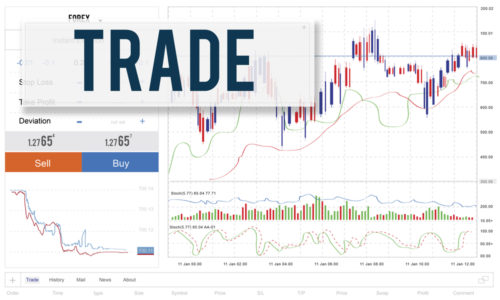A stock is a single stake in the ownership of a company. When you own a stock, you have a small claim on the assets and profits of the company. However, unless you own a good chunk of stock in one specific company, you won’t have much say in how the company is run or the financial decisions made by the CEO.
Companies put different types of stocks up for sale on an exchange so they can grow their business, as an alternative (or supplement) to taking on a business loan. Essentially, it’s a way for these companies to raise money for operations or projects. Investors buy and exchange stocks in the market so they can create their own capital. If all goes well, both the company and the investors make money.
There are two types of stocks: common and preferred stocks. All public companies issue common stocks, and if you’ve ever invested in the stock market, chances are this is the type of stock you purchased. Preferred stocks are only issued by some companies and are similar to bonds. It’s important to learn about the pros and cons of both types of stocks when deciding where to invest in the stock market.
Table of Contents
Common Stock
Common stock is also sometimes referred to as a voting, common, or ordinary share. When you own common stock, you have a guarantee that you have ownership in a company, whether the company profits or fails. For example, if a company offers 100 shares of stock and you buy 10 of these common stocks, you own 10 percent of the company. However, publicly traded companies are usually large, so they may offer millions or billions of shares to investors in the market.
Common stock is the most common type of stock available for purchase on the market. Some of the most notable characteristics of common stock include:
- Voting rights. As a stockholder, you have one vote (per share you own) to elect board members, who are responsible for making major decisions within the company. You may also have a vote on certain corporate policies.
- Dividends. You also have a claim on the dividends, which are portions of profit the company earns. Some companies pay dividends to their stockholders, but the amounts can change over time or be discontinued.
- Value. The value of common stock can rise and fall, and often does so by the minute. There is no limit to how high or low the value of common stock can become.
- Risks. Common stock is considered high risk. If a company goes bankrupt, it’s liquidated, and common stockholders are not paid until after the creditors, bondholders, and preferred shareholders are paid out. Sometimes, there isn’t anything left, and common stockholders lose their investments after company liquidation and payout.
- Rewards. While they are the riskiest type of stock, common stocks also offer some of the best rewards. In the long-term, these types of stocks are known to yield higher returns than any other investment.
Examples of Common Stock
One of the most successful and commonly known examples of common stock is Alphabet, which is the parent company of Google. The company has two different ticker symbols it uses to trade in the stock market, GOOGL and GOOG. According to NASDAQ, there are 2,493 shareholders in GOOG and together, they own over 238,517,456 shares.
Under Armour is an active clothing brand that trades common stocks in the market under the ticker symbol UA. Shareholders can buy common stocks in the company and trade or sell them when stock prices rise to make a profit.
CVS Health Corporation does business on the stock exchange under the ticker symbol CVS. This company also offers common stock, which are bought and sold every minute of the day. This contributes to the consistent rise and fall of the company’s stock value on the market.
Preferred Stock
Preferred stock works differently than common stock because it provides fixed, guaranteed dividends to stockholders. While common stock prices are constantly fluctuating throughout the day, preferred stock prices don’t fluctuate as much. Preferred stock usually has the following features:
- Convertible. In some cases, preferred stock has the ability to convert to common stock.
- Dividends. These payments are made to preferred stockholders before common stockholders are paid and are generally higher than the dividends associated with common stock.
- Voting. Preferred stockholders have limited rights to company decisions and do not hold voting rights like common stockholders do.
- Assets. In the event of company liquidation, preferred stockholders have a greater claim on assets than common stockholders.
Examples of Preferred Stock
Companies may issue preferred stock due to regulations that prohibit them from taking on more debt or if they’re at risk of being downgraded. Generally, institutions are the primary owners of preferred stock because there are certain tax advantages they can benefit from that aren’t available to individuals. These institutions buy preferred stock in bulk, making this type of stock more appealing to public companies that want to raise capital quickly.
When looking for examples of companies that offer preferred stock, you can generally find most participants in the healthcare, communications, or energy industries. Since these industries are typically focused on innovation and growth, companies within these fields generally need capital to keep up. Recognizable companies offering preferred stock include:
Differences Between Common and Preferred Stock
The main difference between a common and preferred stock is the way the investor profits from the investment.
Common Stock Pays Variable Dividends: With common stock, there are variable dividends that are not guaranteed to the stockholder. In some cases, companies don’t offer these dividends at all. The value of the stock is regulated by the market’s supply and demand.
Preferred Stock Pays Guaranteed Dividends: However, with a preferred stock, the stockholder is guaranteed a dividend payment, which is usually higher than the dividend payment for common stocks. This dividend is calculated as the dollar amount divided by the price of the stock. If a company liquidates, preferred stockholders also can claim a higher amount than common shareholders.
When deciding between common or preferred stocks, there are a few other characteristics to consider.
Common Stock Confers Voting Rights: With common stock, you have voting rights in the company and the potential for profit in the long-term. However, if dividends are offered, they’re often worth less than preferred stock dividends, and are not guaranteed.
If the company goes bankrupt, you’re also more likely to lose your common stock investment since you’re the last to receive a payout. Since the stock market can be risky, you may also see more volatility in your investment, but you’re more likely to profit if you leave your investments in the market for a long time.
Preferred Stock Doesn’t Confer Voting Rights: Preferred stocks don’t come with voting rights, but you are guaranteed a fixed dividend, which is generally higher than with common stock. You’ll experience less volatility with preferred stocks and if the company goes bankrupt, you’re more likely to receive a payout. Since preferred stocks aren’t known for long-term growth, you should only consider this investment if you’re looking for a short-term investment or income.
Class A and Class B Stock
With both of the different kinds of stocks, there are certain class distinctions that provide investors with specific rights. Generally, Class A stocks provide investors with more voting rights than Class B stock. Class A stocks also generally provide higher dividends than Class B. However, the company itself can set the guidelines for each class. When a company has two classes of shares, it’s typical for only one class to be publicly traded and the other reserved for private investors. This provides the company with two different ways to raise capital.
Image Source: https://depositphotos.com/





